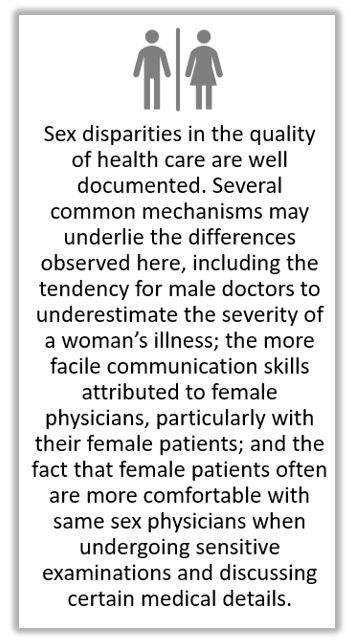- Clinical Technology
- Adult Immunization
- Hepatology
- Pediatric Immunization
- Screening
- Psychiatry
- Allergy
- Women's Health
- Cardiology
- Pediatrics
- Dermatology
- Endocrinology
- Pain Management
- Gastroenterology
- Infectious Disease
- Obesity Medicine
- Rheumatology
- Nephrology
- Neurology
- Pulmonology
Treatment by Female Physicians Linked to Lower Mortality, Hospital Readmissions
Treatment by female physicians resulted in better 30-day outcomes for male and female patients, but the benefit was significantly greater for the women.
When treated by a female physician, both men and women aged 65 years and older experienced lower rates of mortality and hospital readmission, but the benefit for women was greater than for their male peers, according to new research.1
Specifically, the study of Medicare fee-for-service beneficiaries found that 30-day mortality after hospital discharge among women treated by female physicians was lower (8.15%) than among those treated by male physicians (8.38%), a difference study authors described as “large and clinically meaningful” for female patients. For male patients, there was a small difference in mortality based on the sex of the treating physician (female 10.15% vs male 10.23%) that was not statistically significant, ruling out a differential effect.
©imtmphoto/stock.adobe.com

The pattern was similar for 30-day hospital readmission rates, according to senior study author Yusuke Tsugawa, MD, PhD, MPH, associate professor-in-residence of medicine in the division of general internal medicine and health services research at the David Geffen School of Medicine at UCLA, and colleagues. Their findings were published online April 23 in the Annals of Internal Medicine.1
Tsugawa and colleagues cited the growing body of literature demonstrating that practice patterns differ between male and female physicians and that highlights the importance of physician sex in clinical outcomes for patients. Evidence is far more limited regarding whether the effect of physician sex on clinical outcomes actually varies according to sex of their patients, wrote the authors, an information gap their study was designed to help fill.
For the retrospective observational study, the research team collected a 20% random sample of Medicare fee-for-service beneficiaries hospitalized with medical conditions as defined by the Medicare Severity Diagnosis Related Group, between January 2016 and December 2019.
The exposure variables were 4 patient-physician dyads: female patient–female physician, female patient–male physician, male patient–female physician, and male patient–male physician and the study’s primary outcomes were patient mortality and readmission rates 30-days post discharge, adjusted for patient and physician characteristics as well as hospital level averages of exposures.1
The final sample for analysis included 458 108 women and 318 819 men aged 65 years and older Female physicians treated 31.1% of female patients and 30.6% of male patients. Tsugawa et al reported no clinically meaningful differences in patient characteristics between male vs female physicians for male and female patients.
FINDINGS1
Although 30-day mortality rates were lower for both men and women treated by female physicians, female patients experienced a significantly greater benefit (difference-in-differences, -0.16 percentage points [pp], 95% CI, -0.42 to 0.10 pp), according to the study.
Female patients had a lower mortality rate (8.15%) when treated by female physicians compared to when treated by male physicians (8.38%) (average marginal effect [AME], -0.24, 95% CI, - 0.41 to -0.07). The mortality rate for men treated by female physicians was only slightly lower than for men treated by male physicians (10.15% vs 10.23; AME, -0.08, 95% CI, -0.29 to 0.14).

The results for 30-day readmission followed a similar pattern, with rates lower for men and women treated by female physicians. For women, the difference in readmissions between female and male physicians was clinically important (15.51% vs. 16.01%; AME, -0.48, 95% CI, -0.72 to -0.24) but for men, the difference did not reach statistical significance (15.65% vs 15.87%).
The authors point to several study limitations including the potential for unmeasured confounding common to all observational research, the availability of only limited clinical data in medical claims, and the inclusion of an older population which precludes the ability to generalize their findings to younger populations.1
Sex disparities in the quality of health care are well documented and Tsugawa et al suggest several common mechanisms may underlie the differences observed in their study, including the tendency for male doctors to underestimate the severity of a woman’s illness; the more facile communication skills attributed to female physicians, particularly with their female patients, and the fact that female patients are more comfortable with same sex physicians when undergoing sensitive examinations and discussing certain medical details.1
“What our findings indicate is that female and male physicians practice medicine differently, and these differences have a meaningful impact on patients' health outcomes,” Tsugawa said.2 “Further research on the underlying mechanisms linking physician gender with patient outcomes, and why the benefit of receiving the treatment from female physicians is larger for female patients, has the potential to improve patient outcomes across the board.”2
References
Miyawaki A, Jena AB, Rotenstein LS, Tsugawa Y. Comparison of hospital mortality and readmission rates by physician and patient sex. Ann Intern Med. Published online April 23, 2024. doi:10.7326/M23-3163
Treatment from female doctors leads to lower mortality and hospital l readmission rates. News release. UCLA Health. April 22, 2024. Accessed April 23, 2024. https://www.uclahealth.org/news/treatment-female-doctors-leads-lower-mortality-and-hospital
